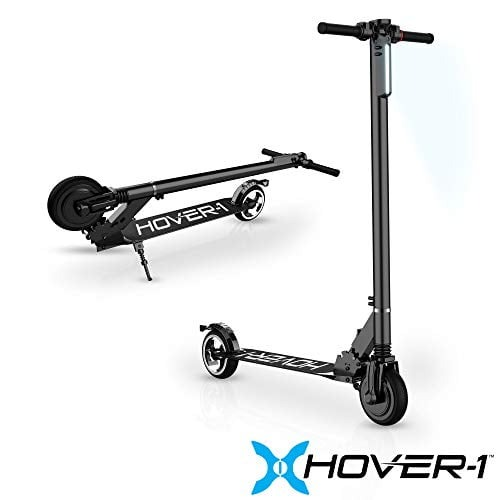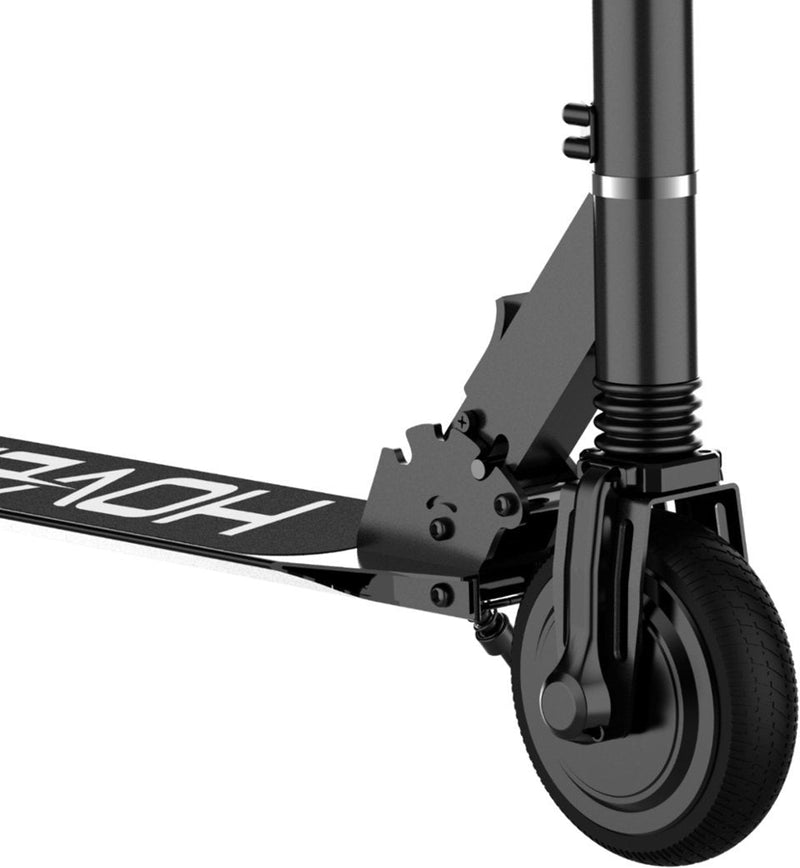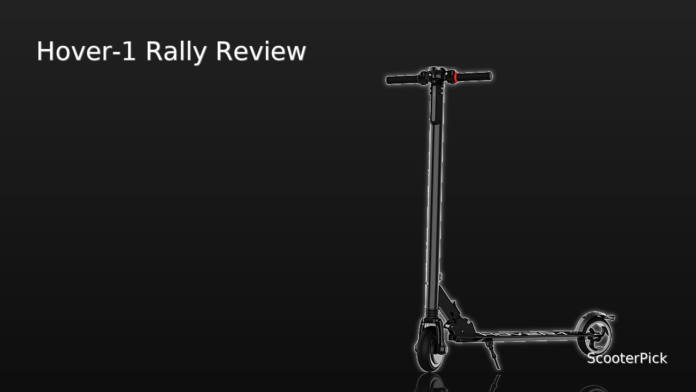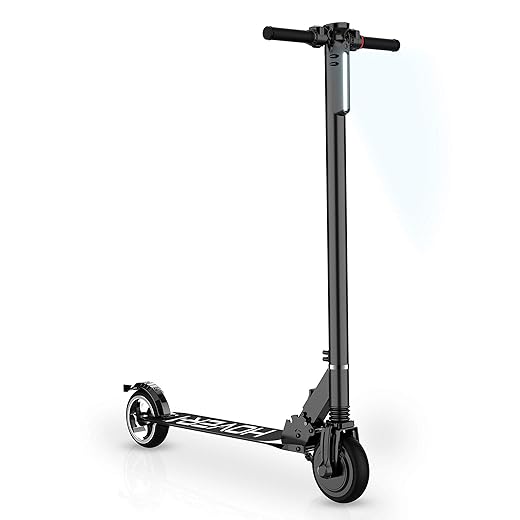If you want a simple, lightweight scooter for quick rides, the Hover-1 Rally sits squarely in that “first e-scooter” spot. This Hover-1 Rally review explains where it excels, where it struggles, and how it behaves on real streets. For a quick spec-tier comparison in the same family, see the Hover-1 Rally link placed here as requested.
Key Specifications
The Rally is an entry-level, foldable commuter with a compact frame, small solid tires, and an easygoing control setup. The table below summarizes the essentials in both imperial and metric.
| Block | Details |
|---|---|
| General | Model: Hover-1 Rally Electric Folding Scooter • Category: Entry-level commuter • Riding posture: Upright, fixed handlebar • Recommended rider age: Teen & adult riders |
| Performance & Power | Motor: 300 W brushless hub (rear) • Top Speed: up to 12 mph (19 km/h) • Claimed Range: up to 7 mi (11 km) • Ride Modes: 2 (Eco/Sport) • Hill Use: Best on gentle inclines; momentum helps |
| Charging & Electrical | Battery: 36 V lithium-ion pack • Charger: 42 V, ~1 A barrel-type • Charge Time: ~4–6 hours • Display: Simple LED readout for speed/battery • Lights: Front LED headlight; rear reflectors |
| Build & Dimensions | Frame: Alloy deck with steel components • Tires: 6.5 in (165 mm) solid rubber, no suspension • Unfolded Size (L×W×H): 41.5 × 16.5 × 44.0 in (105.4 × 41.9 × 111.8 cm) • Folded Size (L×W×H): 41.5 × 16.5 × 19.0 in (105.4 × 41.9 × 48.3 cm) • Scooter Weight: ~25 lb (≈11.3 kg) • Max Rider Weight: 220 lb (100 kg) |
| Safety & Control | Brakes: Electronic (regen) front + mechanical rear foot brake • Traction: Solid tires (puncture-proof) • Bell: Not standard on many units; check your package • Water: No official IP rating—avoid rain and puddles |
| Features & Extras | Cruise Control: Not available • Kickstand: Yes • App/Bluetooth: Not supported • Folding latch: Hand-lever style with stem hook • Deck: Sandpaper-style grip, compact footprint |
| Warranty & Compliance | Warranty: 90-day limited manufacturer warranty • Compliance: UL-style electrical certification (scooter/charger) • Manual/Support: Basic quick-start plus safety guidance |
Design & Build Quality
At a glance, the Rally looks minimal in the best way. The deck runs lean and low, the stem is straight, and the cabling stays tidy. As a result, the stance feels approachable. New riders won’t feel overwhelmed by controls or options. Moreover, the folding mechanism uses a lever-style latch with a catch point on the rear fender for carrying. Once you learn the angle, closing it takes only a few seconds.
Material choices reflect its mission. The frame and deck panels favor light alloys, while the fork and stress points use steel. Therefore, you get a solid-enough ride at neighborhood speeds. The deck grip is sandpaper-like, so shoes plant well even when dust collects. However, space is limited. Larger feet may sit diagonally, and tall riders will notice the compact stance.
The 6.5-inch solid tires define the Rally’s character. They never puncture, which beginners appreciate. On the other hand, they transmit bumps. At slow speeds on smooth asphalt, the scooter feels neat and composed. Over cracks and brickwork, a buzz creeps through your hands and ankles. Because there’s no suspension, the tire compound and modest deck flex do most of the filtering. Consequently, daily routes with broken pavement will feel firm.
The handlebar layout stays simple: a thumb throttle on the right, no lever brake, and a small display that shows speed and battery. Fortunately, that display is bright enough for daytime glances. At night, the front LED headlight works better for being seen than for carving dark paths. Thus, a clip-on helmet light helps if you ride after sunset.
Fit and finish sit where they should for an entry scooter. Panel lines are tidy, fasteners are accessible, and there’s nothing flashy. In short, the build supports the main value proposition: roll out, ride calmly, and fold back up without fuss.

Motor, Power & Acceleration
The rear hub packs a 300-watt motor. That number tells you the target use case: flat city blocks, park paths, and short commuting connectors. Off the line, acceleration feels friendly, not fierce. Because throttle mapping is progressive, the Rally builds speed in a predictable arc. A light push yields walking pace. A firm press nudges you into the 8–10 mph zone. Hold it down on open stretches and you’ll see roughly 12 mph (19 km/h).
Since torque is modest, your technique matters. Kick assist helps the controller ease current demand and spin up cleanly. Give the deck a small push at starts and you’ll feel smoother launches with less motor groan. In crowded spaces, the gentle ramp keeps the scooter manageable. Therefore, you avoid sudden surges that might spook pedestrians.
On mild grades, speed falls predictably. Expect to lose a few miles per hour on 5–6% inclines. Nevertheless, you can maintain momentum if you enter with speed. If you approach slowly, you may need a kick or two. That’s normal for small-motor scooters with tight current limits. The upside shows up in battery life and controller heat management. Consequently, the Rally stays cool and consistent in the role it was designed for.
Two modes—Eco and Sport—change the ceiling, not the personality. Eco holds speed down and squeezes out a touch more distance. Sport gives you the full 12 mph. For mixed routes, most riders leave it in Sport, throttle by feel, and still ride efficiently.
Battery, Range & Efficiency
The Rally carries a 36-volt lithium-ion pack sized for short hops. The claimed range is up to 7 miles (11 km) under gentle conditions. That figure assumes a moderate rider, flat ground, mild temperatures, and steady cruising. In real life, range pivots on three variables: rider weight, terrain, and how often you sprint to top speed. Because the controller is conservative, the scooter tends to ride at sensible currents, which helps efficiency.
Plan your commute around 3–6 miles (5–10 km) between charges if your route includes stops, mild hills, or rougher surfaces. On clean flats with a light rider in Eco mode, you can approach the claim. Conversely, cold mornings will shave distance, while warm but not hot days return the best performance. Therefore, match expectations to weather and route profile.
Charging is straightforward. The 42-volt barrel charger plugs into a port usually capped on the deck or stem base. Expect about 4–6 hours from near empty to full. It’s a set-and-forget routine for home or office. As a best practice, avoid storing the battery completely full or completely empty for long periods. Instead, keep it roughly 40–70% if you plan to park it for several weeks. That habit supports cell longevity.
Another quiet benefit stands out: the modest top speed and current ceiling reduce stress on the pack. Many small scooters lose capacity quickly when pushed to their limits. By contrast, the Rally’s gentle envelope helps preserve health, especially if you keep the charge port clean and avoid riding in wet conditions.
Ride Quality, Handling & Comfort
Ride comfort tracks closely with tire size and compliance. On the Rally, 6.5-inch solid tires prioritize durability over plushness. On smooth bike paths, the scooter glides nicely. However, on chip seal or patched asphalt, you’ll feel a treble vibration through the deck and bars. That sensation remains controlled up to top speed, yet it limits how long you’ll want to ride in one stretch.
Balance is predictable. Because the deck sits low, stability improves as you thread between obstacles. The steering is light yet not twitchy. Since the chassis is compact, it favors small inputs. A little lean or bar turn yields a quick line change. Consequently, new riders adapt quickly and start looking ahead, planning flow through crosswalks and driveways.
At speed, the Rally stays composed. With weight centered and knees slightly bent, you can absorb fine chatter better than you’d expect from a small-wheel scooter. Strong crosswinds will nudge you, though, so keep both hands on the bars and hold a steady line. Tall riders may find the bar height a bit low; a wider stance or a diagonal foot position helps.
Noise stays minimal. The hub motor hums quietly, and the solid tires drum a bit on rough surfaces. Nothing rattles if you keep hardware snug. Therefore, a quick weekly check on the folding latch bolts and fender screws pays off by preventing buzz from developing.

Braking & Safety Features
The Rally uses a two-part braking scheme: electronic regenerative braking on the motor side and a mechanical foot brake over the rear fender. The electronic component gently slows the rear hub when you roll off the throttle or engage the brake control, capturing a touch of energy back into the pack. It feels smooth rather than abrupt, which builds confidence.
The foot brake is old-school and effective at these speeds. Press the fender with your heel and weight, and friction slows the wheel quickly. That method requires practice. Keep your hips square, shift your center of mass forward slightly, and apply progressive pressure. Otherwise, a sudden stamp can lock the tire and skid.
At 12 mph, the combination is adequate. You can stop confidently within a short neighborhood distance on dry pavement. In wet conditions, stopping distances grow. Because the Rally has no official water rating, it’s better to avoid wet rides entirely. If you must cross damp patches, reduce speed and leave extra space.
Lighting is basic. The white LED headlight increases conspicuity but won’t flood far ahead. Use it to be seen and supplement with a helmet-mounted light for true path illumination. Rear reflectors help with visibility from behind. Additionally, adhesive side reflectors boost cross-traffic awareness.
Ultimately, anticipation remains the strongest safety tool. Look far ahead, roll off early, and keep speeds gentle where visibility drops or foot traffic rises. The scooter’s friendly temperament supports that thoughtful style.
Portability & Daily Usability
Portability is the Rally’s headline strength. At roughly 25 lb (≈11.3 kg), you can carry it up two flights without much drama. The folded height—about 19 in (48.3 cm)—means it tucks behind a café chair, under a desk, or in a car trunk. The stem hook clips to the rear fender for carrying. That hook keeps the package together while you move; nevertheless, lift from the stem rather than the deck. For a similarly compact alternative, consider the Joyor F3, which also emphasizes easy carrying and everyday practicality.
The compact wheelbase and solid tires simplify ownership. You’ll never fix a flat. You won’t fuss with inner tubes or sealant. You can roll through glass-free alleys and ignore the tire pump. On the flip side, comfort suffers on cobbles and cracked sidewalks. Consequently, choosing smoother lines becomes part of the daily routine. If your city paves bike paths well, the Rally shines.
Controls are easy. One power button, two modes, a throttle, and a foot brake. New riders figure it out in under a minute. That simplicity encourages short, frequent trips. Quick gym run? Groceries a mile away? Because the Rally folds quickly, it turns errands into easy yeses. As your confidence builds, plan return routes that keep grades mellow and surfaces kinder.
Storage is painless. The footprint—41.5 × 16.5 in (105.4 × 41.9 cm)—fits most closets. The kickstand is sturdy for the weight. Just avoid damp rooms and wipe down the deck after dusty rides. A small silicone cap usually protects the charge port; keep it seated to block debris.
Features, App & Extras
This model stays offline by design. There’s no Bluetooth app, ride logging, or OTA tinkering. Consequently, you power on, select a mode, and go. Some riders love that approach because there are fewer settings to tweak and fewer updates to chase. Others may miss extras like cruise control or adjustable acceleration curves. If you prefer deeper tuning, the Rally isn’t that scooter.
Practical extras do make the cut. A kickstand supports easy parking. The folding latch is friendly to fingers once you learn the motion. The display shows the basics clearly. The headlight, while modest, covers low-speed visibility in lit neighborhoods. Consider adding a bar-mounted bell if your unit doesn’t include one. It’s a small, high-value upgrade for shared paths.
Because the tires are solid, your spares kit shrinks. Pack an L-key, a small Phillips driver, and a compact wrench for periodic bolt checks. Also, keep a microfiber cloth to wipe dust from reflectors and the headlight lens. Visibility wins safety points every ride.

Charging Experience & Maintenance
Plug-and-go charging keeps ownership simple. The 42-volt charger is light, and a small LED shows charge state. Let the scooter rest a few minutes after hard rides before charging. Cells prefer not to jump from full load to charge immediately. Likewise, avoid running the pack to zero. Stop around one bar and top up when convenient.
Maintenance centers on fasteners and cleanliness. Once a week, confirm the folding clamp’s tension and check the fender screws. Every few weeks, inspect the throttle action for grit and the deck grip for peeling edges. Clean with a damp (not wet) cloth. Avoid pressure washers or hose spray. Because the Rally lacks a stated water protection rating, the electronics benefit from gentle care.
Brake habit also plays into maintenance. Use electronic braking first by rolling off. Add the foot brake progressively. Skid less, and your rear tire wears evenly. Solid tires last a long time; however, they still abrade. If you ride frequently on sharp aggregate, rotate your stance now and then so your weight doesn’t grind a single spot.
Store the scooter at room temperature. Extreme heat and cold degrade lithium cells. If your garage swings widely in temperature, bring the scooter indoors. Over time, that small step preserves useful range.
Who the Hover-1 Rally Is For
The Rally suits new riders who value simplicity and low weight over speed. If most of your trips are 1–3 miles (1.5–5 km) on smooth paths, you’ll appreciate the quiet motor, easy controls, and quick folding. Students, first-time commuters, and riders with elevator access will find it painless to lift and stash.
Terrain matters. If your route includes long hills, look elsewhere. The motor prefers flats and mild grades. If your pavement is rough, be honest about comfort. Short stints feel fine. Long rides over broken asphalt will feel buzzy. In cities with well-maintained bike lanes, the Rally’s compact dimensions become a plus. You can thread busy corridors smoothly at safe, modest speeds.
Rider size also plays a role. The max load is 220 lb (100 kg). Heavier riders can still use it, but acceleration and hill-holding fade. Shorter riders will like the fixed handlebar height; taller riders can adapt with a diagonal foot stance and bent ankles for compliance.
Finally, personality counts. If you want an app, cruise control, or high-tinker features, the Rally’s minimalism may feel bare. If you want a reliable little scooter that “just rides,” you’ll feel at home.
Value for Money & Verdict — Hover-1 Rally Review
Value shows up in two ways: what a scooter does, and what it doesn’t ask of you. The Rally focuses on essential transport. It’s light to carry, easy to ride, and almost maintenance-free. You trade away suspension, higher speed, and app extras. For short, flat commutes, that’s a fair deal.
The frame doesn’t creak, the latch works, and the electronics behave predictably. Range aligns with the modest motor and battery. On flats, the 12 mph (19 km/h) cap is sensible around pedestrians and bike paths. On gentle grades, the scooter slows without drama. Therefore, plan to keep momentum and accept the calm personality.
The main takeaways are clear: treat the Rally as a neighborhood connector, not a high-performance machine. If you live in a city with smooth lanes and short distances, it delivers exactly what it promises—simple, light, dependable rides—without constant tweaks or tire worries.
Pros & Cons
Pros
- Very light and compact; easy to carry upstairs and store under a desk.
- Simple controls with a friendly throttle map for beginners.
- Solid tires eliminate flats and reduce maintenance chores.
- Folding latch is quick once you learn the angle.
- Predictable braking at neighborhood speeds.
- Quiet motor and tidy cable routing for a clean look.
- Reasonable charge time for short daily rides.
Cons
- No suspension and small solid tires transmit bumps.
- Limited hill performance; prefers flat terrain.
- Modest range; plan around short routes.
- Headlight is more “be seen” than “see far.”
- No app, no cruise control, and few tuning options.
- No official water rating; avoid wet conditions.
- Deck space is tight for large feet or very tall riders.
Price
FAQs
Is the Hover-1 Rally good for beginners?
Yes. The gentle throttle, simple controls, and low top speed make it very beginner-friendly.
How far can the Rally go on a charge?
Under ideal conditions you can reach about 7 mi (11 km), but most mixed routes will land slightly lower.
Can I ride it in the rain?
There’s no official water protection rating. Therefore, avoid rain, puddles, and hose spray to protect electronics and the battery.
Does it have cruise control or an app?
No. The Rally keeps things simple with two ride modes, a thumb throttle, and a basic LED display.
How does it climb hills?
It handles mild grades with momentum. However, expect speed to drop on 5–6% slopes, and add a kick if needed.
What maintenance does the Rally need?
Perform occasional bolt checks, clean the deck and lights, and follow sensible charging habits. Solid tires remove flat repairs.
Where can I read a detailed Hover-1 Rally review?
You’re reading it here—this Hover-1 Rally review covers design, power, range, comfort, and daily use.



